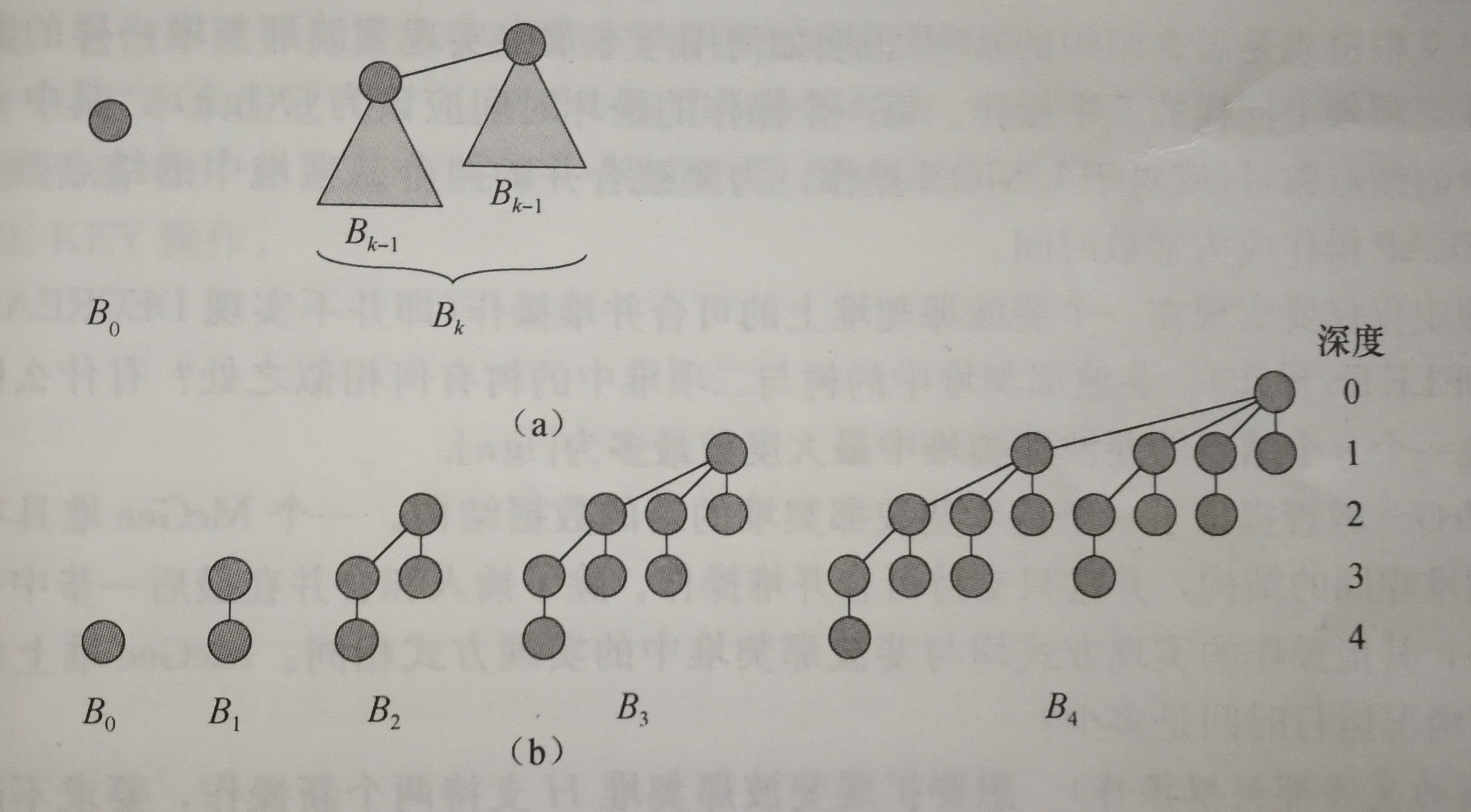二项树是一颗递归定义的树。B0只有一个节点。二项树Bk由两棵二项树B(k-1)组成的,其中一棵树是另一棵树根的最左孩子。
二项树性质:
1. Bk共有2^k个节点。
2. Bk的高度为k。
3. Bk在深度i处恰好有C(k,i)个节点,其中i=0,1,2,...,k。
4. 根的度数为k,它大于任何其它节点的度数。把孩子编号从左到右为k-1,k-2,...,0。则孩子i为子树Bi的根。
二项树性质:
1. Bk共有2^k个节点。
2. Bk的高度为k。
3. Bk在深度i处恰好有C(k,i)个节点,其中i=0,1,2,...,k。
4. 根的度数为k,它大于任何其它节点的度数。把孩子编号从左到右为k-1,k-2,...,0。则孩子i为子树Bi的根。
二项堆:
1. 每个结点只有一个关键字。
2. 每棵二项树都满足最小堆性质。
3. 对非负整数k,H中最多有一个二项树的根的度数为k。
4. 结点数为n的二项堆最多只有 [lg(n)]+1 棵二项树( [lg(n)]向下取整 )
1. 每个结点只有一个关键字。
2. 每棵二项树都满足最小堆性质。
3. 对非负整数k,H中最多有一个二项树的根的度数为k。
4. 结点数为n的二项堆最多只有 [lg(n)]+1 棵二项树( [lg(n)]向下取整 )

template<class T>
struct Node
{
T data;
int degree;
Node<T>* left;
Node<T>* parent;
Node<T>* next;
Node(T k)
{
left = nullptr;
parent = nullptr;
next = nullptr;
degree = 0;
data = k;
}
Node()
{
left = nullptr;
parent = nullptr;
next = nullptr;
degree = 0;
}
};
template<class T>
class HeapTwo
{
private:
Node<T>* head;
public:
HeapTwo(Node<T>* s)
{
head = s;
}
HeapTwo()
{
head = nullptr;
}
~HeapTwo();
void Destory(Node<T>* q);
//c变成heap的左孩子
friend void Link(Node<T>* c, Node<T>* heap);
//将两个堆的根结点按度数大小排序
friend Node<T>* SortMerge(Node<T>* h1,Node<T>* h2);
//合并
friend Node<T>* Union_F(Node<T>*& h1, Node<T>*& h2);
void Union(HeapTwo<T>& h);
//插入
void Insert(T key);
//搜索
Node<T>* Search_(Node<T>* q,T key);
Node<T>* Search(T key);
//删除
void Delete(T key);
Node<T>* reverse(Node<T>* root);//分离出单个二项堆并反转 因为一个根节点下最左孩子度数最大(堆要求根结点度数从小到大排序)
//打印堆
void Out_(Node<T>* q);
void Out();
void top(Node<T>*& x,Node<T>*& pre);
T min();
T pop();
void Decrease(Node<T>* q, T key);
void Crease(Node<T>* q, T key);
};
template<class T>
void HeapTwo<T>::Destory(Node<T>* q)
{
if (!q)
return;
Node<T>* p = q->left;
while (p != nullptr)
{
p = p->next;
}
Destory(q->next);
delete q;//递归到边界,开始delete
}
template<class T>
HeapTwo<T>::~HeapTwo()//析构
{
Destory(head);
}
template<class T>//递归打印堆
void HeapTwo<T>::Out_(Node<T>* q)
{
if (!q)
return;
cout << q->data << " -> ( ";
Out_(q->left);
cout << " )";
Out_(q->next);
}
template<class T>
void HeapTwo<T>::Out()
{
Out_(head);
cout << endl;
}
template<class T>
void Link(Node<T>* c, Node<T>* heap)//c作为heap的left孩子
{
c->parent = heap;
c->next = heap->left;
heap->left = c;
heap->degree += 1;
}
//将两个堆的根结点按度数大小排序
template<class T>
Node<T>* SortMerge(Node<T>* h1, Node<T>* h2)
{
Node<T>* q1 = h1;
Node<T>* q2 = h2;
Node<T>* head = nullptr;
Node<T>** q = &head;//指向指针的指针,便于直接修改next值
while (q1&&q2)
{
if (q1->degree < q2->degree)//度数小的在前
{
*q = q1;
q1 = q1->next;
}
else
{
*q = q2;
q2 = q2->next;
}
q = &((*q)->next);//q指向原q的next值,便于在 *q=q1/q2 时直接更新next
}
if (q1)
*q = q1;
else
*q = q2;
return head;
}
template<class T>
Node<T>* Union_F(Node<T>*& h1, Node<T>*& h2)
{
Node<T>* q = SortMerge(h1, h2);
Node<T>* root = q;
if (q == nullptr)
return nullptr;
//度数相同的二项树最多有两个
//当只有两个相同时直接将两个合并
//当有三个子树的度数都相同,合并后两个(第三个子树是在合并过程中产生的)
//维护三个指针,为当前结点,前一个结点和下一个结点
Node<T>* next = q->next;
Node<T>* pre = nullptr;
while (next != nullptr)
{
if (q->degree != next->degree)//不必合并
{
pre = q;
q = next;
next = q->next;
}
else if (next->next != nullptr&&q->degree == next->degree&&
next->degree == next->next->degree)//三个都相同,暂时不做操作,下一步合并后两个
{
pre = q;
q = next;
next = q->next;
}
//合并
else if (q->data <= next->data)//q不移动,q的度数变化可能和后边的子树冲突
{
q->next = next->next;
Link(next, q);//next作为孩子,更新next值
next = q->next;
}
else
{
if (pre == nullptr)//q作为孩子,若q为head节点,更新head;否则由于q消失,更新pre->next
{
root = next;
}
else
{
pre->next = next;
}
Link(q, next);
q = next;
next = q->next;
}
}
//原堆失效
//防止原堆析构时破坏新的堆
h1 = nullptr;
h2 = nullptr;
return root;
}
template<class T>
void HeapTwo<T>::Union(HeapTwo<T>& h)
{
head = Union_F((*this).head, h.head);
}
//产生一个新的堆,合并到原来的堆
template<class T>
void HeapTwo<T>::Insert(T key)
{
Node<T>* q = new Node<T>(key);
HeapTwo<T> Q(q);
Union(Q);
}
template<class T>
Node<T>* HeapTwo<T>::Search_(Node<T>* q, T key)
{
Node<T>* p = q;
Node<T>* ans;
while (p != nullptr)
{
if (p->data > key)
{
p = p->next;
continue;
}
if (p->data == key)
return p;
else
{
if (ans = Search_(p->left, key))//递归
return ans;
}
p = p->next;
}
return nullptr;
}
template<class T>
Node<T>* HeapTwo<T>::Search(T key)
{
return Search_(head, key);
}
template<class T>
Node<T>* HeapTwo<T>::reverse(Node<T>* root)
{
Node<T>* pre = nullptr;//q的前一个,便于反转next值
Node<T>* q=root;
Node<T>* next;
if (!q)
return root;
while (q->next)
{
next = q->next;
q->next = pre;
q->parent = nullptr;
pre = q;
q = next;
}
q->parent = nullptr;
q->next = pre;
return q;
}
//从要删除的结点开始一路替换至一个根结点,代替的删除根结点
template<class T>
void HeapTwo<T>::Delete(T key)
{
Node<T>* x = Search(head, key);
if (x == nullptr)
return;
Node<T>* p = x->parent;
while (p)
{
T t = x->data;
x->data = p->data;
p->data = t;
x = p;
p = p->parent;
}
//找x前一个子树的根
Node<T>* pre = nullptr;
Node<T>* n = head;
while (n != x)
{
pre = n;
n = n->next;
}
if (pre)
pre->next = x->next;
else
head = x->next;
//删除x,x子树变成一个堆,合并到原堆上
HeapTwo<T> Q(reverse(x->left));
Union(Q);
delete x;
}
template<class T>
void HeapTwo<T>::top(Node<T>*& x, Node<T>*& pre)
{
if (head == nullptr)
throw "No Heap is empty! Can't pop! -1\n";
pre = nullptr;
x = head;
Node<T>* q = head->next;
Node<T>* qpre = head;
while (q)
{
if (q->data < x->data)
{
x = q;
pre = qpre;
}
qpre = q;
q = q->next;
}
}
template<class T>
T HeapTwo<T>::min()
{
Node<T>* min, *pre;
try
{
top(min, pre);
}
catch (const char* a)
{
cerr << a;
return -1;
}
return min->data;
}
template<class T>
T HeapTwo<T>::pop()
{
Node<T>* min, *pre;
try
{
top(min, pre);
}
catch (const char* a)
{
cerr << a;
return -1;
}
if (pre == nullptr)
head = head->next;
else
pre->next = min->next;
Node<T>* child = reverse(min->left);
HeapTwo Q(child);
Union(Q);
T ans = min->data;
delete min;
return ans;
}
template<class T>
void HeapTwo<T>::Decrease(Node<T>* q, T key)
{
if (key > q->data)
{
cerr << "Can't decrease to a less key!\n";
return;
}
q->data = key;
Node<T>* pre = q->parent;
while (pre&&q->data < pre->data)
{
T t = q->data;
q->data = pre->data;
pre->data = t;
q = pre;
pre = q->parent;
}
}
template<class T>
void HeapTwo<T>::Crease(Node<T>* q, T key)
{
if (q->data > key)
{
cerr<< "Can't crease to a greater key!\n";
}
q->data = key;
Node<T>* child = q->left;
Node<T>* min;
while (child)
{
if (q->data > child->data)
{
min = child;
child = child->next;
while (child)
{
if (min->data > child->data)
min = child;
child = child->next;
}
T t = q->data;
q->data = min->data;
min->data = t;
q = min;
child = q->left;
}
else
{
child = child->next;
}
}
}